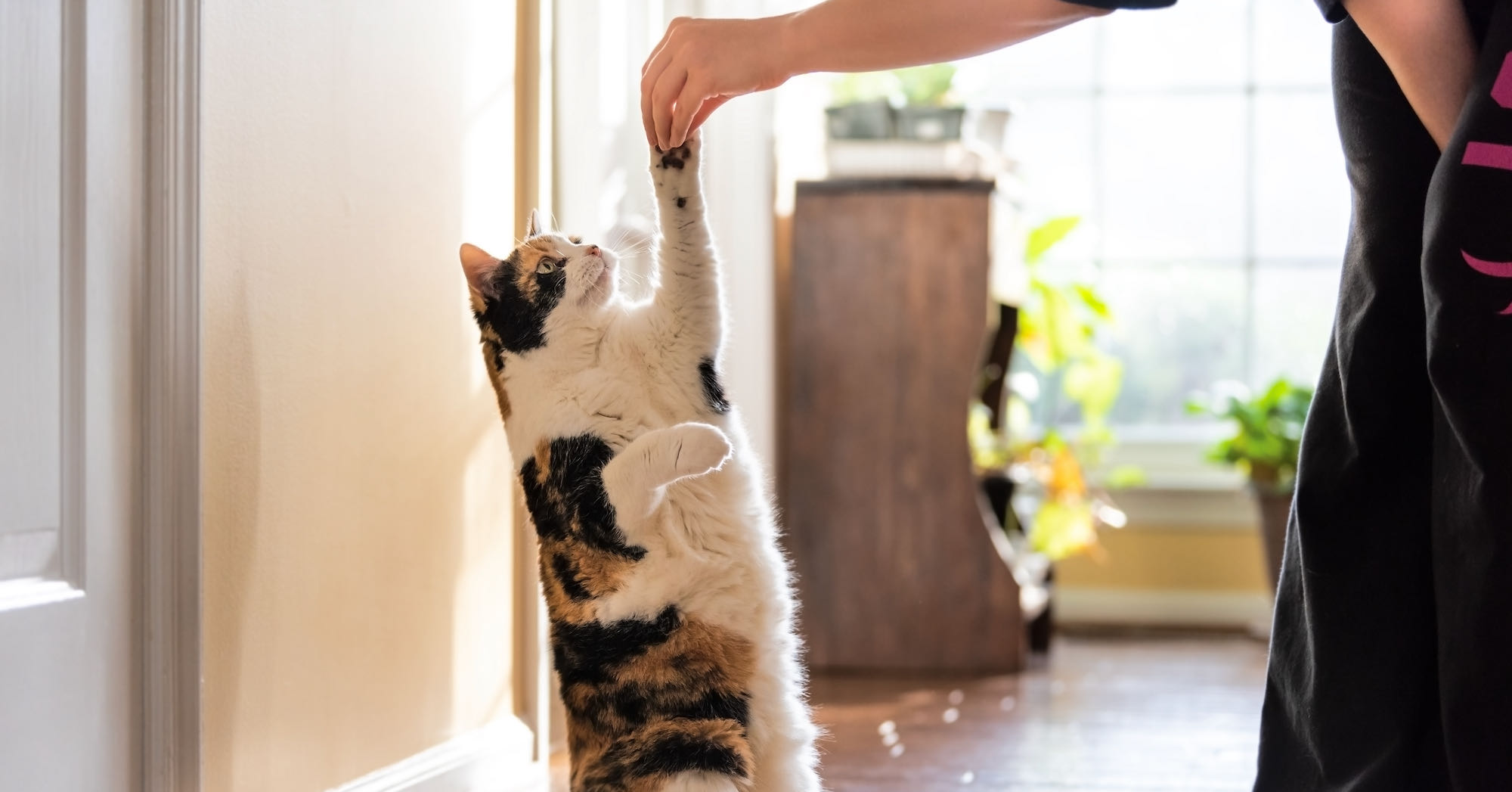Key Points:
- Cats may have a mind of their own, but with a little patience (and the right snacks), they can learn to follow some basic commands.
- Training helps your cat avoid the usual trouble spots, like scratching your favorite furniture or leaping onto the counters uninvited.
- Cats don’t have marathon attention spans, so keep the sessions quick and positive, and always end with a tasty reward to keep them coming back for more.
Picture this: you’re lounging on the couch, and your cat strolls by, tail high in the air, as if to say, “I run this place.” Cats have a reputation for being independent and, well, a little bossy. So, can you really train a creature that’s more likely to rule the house than follow the rules?
Surprisingly, yes, you can train a cat — if you make it worth their while.
Most pet parents never consider training a cat because they assume they’re too independent. But this certainly isn’t the case. With a little patience and the right techniques, your cat could be sitting, staying, and even high-fiving in no time.
In this guide, you’ll discover how to unlock your cat’s potential — no magic wand required. You’ll also learn why cat training is an essential part of any new kitten checklist, expert training tips, and a few common commands that will benefit you and your feline friend.
Cat training 101
You can train your cat just like any other pet (even adult cats can learn to follow commands). Here are some helpful techniques to get you started.
Stock up on treats
Unlike dogs, cats won’t be as eager to learn. You can reward your dog with attention and praise, but most cats are only interested in bribes. That means you must woo your cat with treats. To make the most of your training sessions, be sure to stock up on their favorite treats and delicious cat food. Specialty cat treats, like spreadable purées, can be particularly helpful.
Find the best time
Cats’ daily lives follow a predictable cycle of hunting (or playing), eating, grooming, and sleeping, so you’ll want to fit training sessions into their routine. Try training your cat right after they wake up from their nap. They’ll be ready to play and more likely to focus. They’ll also be hungry, which means they’ll work extra hard for those tasty treats.

Keep training sessions brief
Cats have short attention spans. Consistent training sessions under 15 minutes is long enough to accomplish the goal but short enough to keep your cat focused. Remember: the goal should be progress, not perfection.
Eliminate distractions
A distracted cat can’t focus. Find a quiet place away from any pets and members of the family for your training session. Any background noise can throw your cat off, making the training session unproductive.
Be consistent with cues
To avoid confusion, use a specific signal (such as a hand gesture or verbal cue) for the command you want to achieve. Making sure family members also know the right signals and cues will help maintain consistency.
Only train one skill at a time
Trying to teach a cat multiple skills at once can overload them. Only after your cat masters one skill should you move on to the next.
Repeat, repeat, repeat
Repetition reinforces cat behavior. Once your cat masters the skill, make sure you repeat it frequently outside of a training session so your cat doesn’t forget it.
Use positive reinforcement
Focus on the desirable behavior you want your cat to continue rather than the behavior you want them to stop. Yelling, swatting, or spraying your cat for unwanted behavior won’t be productive. Your cat will likely just avoid you.
Remember: Learning new behaviors or solving behavior problems takes time. Be patient with your cat while they’re learning a new skill; they’re more than capable and very intelligent.
Common cat training methods
Whether you use a clicker, hand signals, voice cues, or a combination of all three, here are some cat training methods you can use.
Clicker training
Clicker training is a very effective cat training method. All you need is a tool that makes a gentle clicking sound like a training clicker, a pen, or even your tongue.
The goal is to first associate the clicking sound with a reward, and then further associate a new skill or desired behavior with the click, so your cat knows they’ll be rewarded. You’re creating a cycle of positive reinforcement.
Hand signals
Using hand signals is another great way to train your cat. The key is to associate different commands with hand gestures. For example, making a fist when you want your cat to sit or making an open palm when you want them to give you a high five.
Voice cues
Voice cues are specific words associated with a verbal command. Similar to hand signals, the key is to associate a word with a behavior and reward when the task is done. For example, saying “sit” to get them to sit or saying their name to get them to walk to you.

What behaviors can cats learn (and unlearn)?
When learning how to train a cat, here are some common positive and negative behaviors to focus on.
Litter box training
Most kittens and cats instinctively know to use the litter box. However, if your new kitty is struggling, you can litter box train them fairly quickly.
Make sure the box is clean and in a quiet place. After your kitty eats, move them to the litter box and gently scratch the litter with one of their front paws. After they pee or poop, reward them and remove them from the box. Do this consistently, and they will soon figure out the litter box is their elimination area.

Carrier training
Carrier training can teach cats that the carrier is a safe place to be. This makes traveling with your cat easier.
First, leave the carrier door open and put a favorite toy or a treat inside it. When your cat enters the crate, give them some positive reinforcement like a pet or a chin-scratch. Once your cat is comfortable, try closing the door. Start with just a few seconds and slowly build up as your cat gets more comfortable with the door being closed.
Sitting
Teaching your cat to sit can come in handy. Simply stand or sit in front of your cat, and when they sit naturally, reward them. Start using a “sit” cue (either a hand or verbal cue) after they start sitting in anticipation of the treat. Soon they’ll develop a positive association between the cue and the behavior.
Giving high-fives
The high-five is a fun party trick. Start by having your cat sit in front of you, and offer them a treat. If your cat’s paw comes off the ground, give them a treat. Once your cat is reaching for your hand, raise it up in small increments. Your cat will soon reach higher and higher for the treat. When your cat is finally performing the high-five consistently, replace the treat with praise and chin scratches.
Staying off kitchen counters
Cats love to jump on countertops, which can be unnerving and cause damage. Training a cat to stay off the kitchen counter is possible by using double-sided tape or an object the cat doesn’t like to discourage them.
If they jump on the counter, calmly and gently put them back on the ground until they get the hint.
Biting or kicking with hind legs
It’s not uncommon for cats to bite or kick, but it can become a problematic behavior. If your cat bites or kicks because of a boundary or privacy issue, respect your cat’s space. However, if your cat bites or kicks out of rough play, disengage and ignore your cat. When your cat stops being rough, reward the calm behavior.
Try putting a treat or some cat food on the back of your hand or fingers. By letting your cat lick the treat off your hand, they learn a better way to engage with your hand when in a playful mood.
Scratching furniture
The easiest way to prevent scratching furniture is to provide a scratching post. If that doesn’t solve the problem, place double-sided tape over the area to discourage your cat from using it.
Keep in mind: Cats use scratching posts to claim territory and leave their pheromones around. Show your cat love by giving them a safe scratching area.
Destructive chewing
Not only is destructive chewing annoying to deal with, but it can also be very dangerous. This is especially true if your cat likes to chew on electrical cords.
Prevent destructive chewing by hiding tempting objects or spraying them with a bitter apple deterrent. You can also redirect your kitty to chew sticks or other cat toys like catnip balls.
Eating houseplants
Many houseplants are poisonous to cats. The best rule is to avoid having these types of plants in your home altogether. If that’s not possible, the next best thing is to seclude them in one area and put double-sided tape, a screen, or foil around the base of the plant.
Consider adding foil strips in the pot to discourage your cat from climbing into it. Or offer your cat a safe alternative like cat grass when they feel the need to chomp on some greens.
Yowling for food
Like clockwork, some cats will start yowling and meowing close to mealtime to get your attention.
The best way to stop incessant cat meows is by simply ignoring the behavior. Your cat will soon learn there is no reward for this and stop. Try making them sit while you prepare their food to show them only good behavior will get them what they desire. Unfortunately, this technique takes time and patience — sometimes, a lot of patience.
If you’re struggling to redirect your cat’s bad behavior, then you may need to invest in animal behavior training.
Can all cats be trained?
Cat training is absolutely possible, though each cat’s personality plays a role. The goal is to help them connect positive behavior with something rewarding, using the right motivation and plenty of patience. Even adult cats can learn fun tricks with practice.
To protect your cat in case of future accidents or health needs, learn how a Pumpkin pet insurance plan can help cover eligible vet bills down the line.
FAQs about cat training
- https://www.dailypaws.com/cats-kittens/cat-training/clicker-training-for-cats
- https://www.cafva.org/train-your-cat-to-come-when-called/
- https://www.aspca.org/pet-care/cat-care/common-cat-behavior-issues/destructive-scratching
- https://www.nomnomnow.com/learn/article/everything-you-need-to-know-about-cat-pheromones




